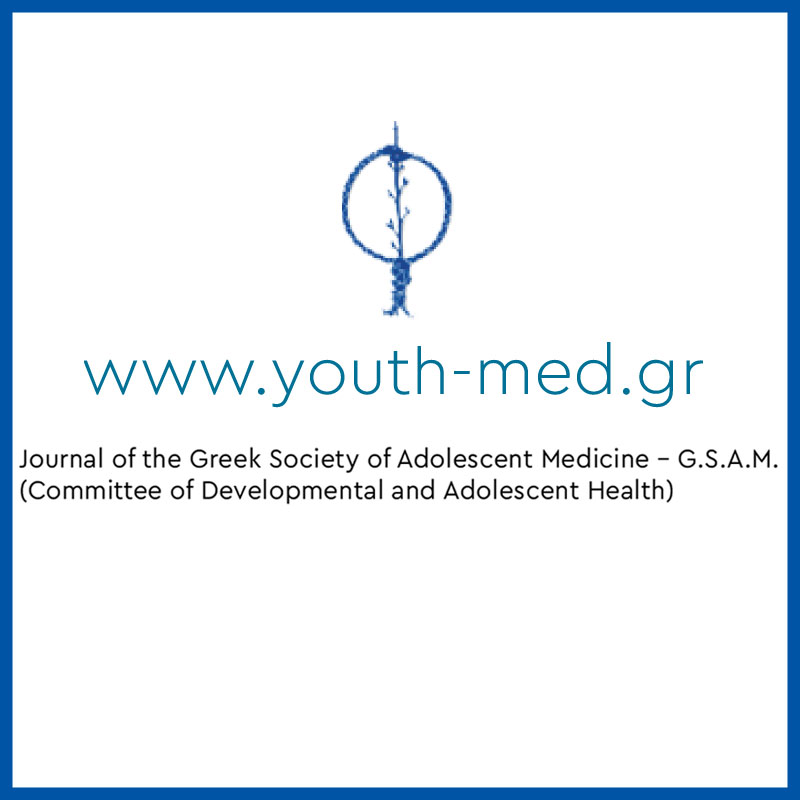Sexual practices in relation to psychosocial status of Greek adolescents
https://doi.org/10.54088/8uhj
Keywords:
Adolescence, Sexual behavior, Sexuality, Psychosocial Functionality, Qualitative studyAbstract
Sexual behavior is considered to be an important aspect in adolescents’ life and constitutes the focus of this study, as it may have consequences in physical and mental health. In the current study 1096 adolescents participated, with mean age 15 years, while qualitative methodology was used. The results presented were varied. Adolescents who were sexually active had higher scores in conduct problems scales and hyperactivity. Adolescents who were forced to have sex, had higher scores in all scales, except from pro-social scale and in total score, while adolescents with higher academic performance in last year (scoring 18 to 20 out of 20 rating scores) were less likely to have sexual experiences comparing to adolescents with grades under 15 out of 20. Finally, preventive and educational measures for students in sexuality could prevent negative consequences and challenges could be faced.
References
Ott, M. A. (2010). "Examining the development and sexual behavior of adolescent males": Erratum. Journal of Adolescent Health, 47(3), 318
Geldard, K., Geldard, D.,& Yin-Foo, R. (2017). Counseling psychology in adolescents: The preventive approach. Athens: Pedio.
Petersen, J. L., & Hyde, J. S. (2010). A meta-analytic review of research on gender differences in sexuality, 1993–2007. Psychological Bulletin, 136(1), 21–38.
Frisco, M. L. (2008). Adolescents' sexual behavior and academic attainment. Sociology of Education, 81(3), 284-311
Alexatou, E. (2018). Adolescent sexual behavior. Knowledge, practices and factors that affect it. Study for first-year students of the TEI of Western Greece in Patras.
Tracy, E. M., Laudet, A. B., Min, M. O., Kim, H., Brown, S., Jun, M. K., & Singer, L.(2012). Prospective patterns and correlates of quality of life among women insubstance abusetreatment. Drug and alcohol dependence, 124(3), 242-249.
Sofuoğlu, Z., Sariyer, G., Aydin, F., Cankarde, S., &Kandemirci, B. (2016). Child abuse andneglect among children who drop out of school: a study in Izmir, Turkey. Social workin public health, 31(6), 589-598.
Garner, D. M., Olmsted, M. P., Bohr, Y., &Garfinkel, P. E. (1982). The eating attitudes test: psychometric features and clinical correlates. Psychological medicine, 12(4), 871 -878.
Tsitsika, A., Janikian, M., Wójcik, S., Makaruk, K., Tzavela, E., Tzavara, C., Greydanus, D., Merrick, J., & Richardson, C. (2015). Cyberbullying victimization prevalence and associations with internalizing and externalizing problems among adolescents in six European countries. Computers in Human Behavior, 51, 1-7.
Tsimtsiou, Z., Haidich, A. B., Kokkali, S., Dardavesis, T., Young, K. S., &Arvanitidou, M. (2014). Greek version of the Internet Addiction Test: A validation study. Psychiatric Quarterly, 85(2), 187-195.
Kwon, M., Lee, J. Y., Won, W. Y., Park, J. W., Min, J. A., Hahn, C., Gu, X., Choi, J.,& Kim, D. J. (2013). Development and validation of a smartphone addiction scale (SAS). PloS one, 8(2), e56936.
Tsitsika, A., Greydanus, D., Konstantoulaki, E., Bountziouka, V., Deligiannis, I.,Dimitrakopoulou, V., Critselis, E., Tounissidou, D., Tsolia, M., Papaevagelou, V.,Connstantopoulos, A., &Kafetzis, D. (2010). Adolescents dealing with sexuality issues: a cross-sectional study in Greece. Journal of pediatric and adolescent gynecology, 23(5), 298-304.
Garnefski, N., &Diekstra, R. F. (1997). Child sexual abuse and emotional and behavioral problems in adolescence: Gender differences. Journal of the American Academy of Child & Adolescent Psychiatry, 36(3), 323-329.
Holmberg, L. I., &Hellberg, D. (2010). Sexually abused children. Characterization of these girls when adolescents. International Journal of Adolescent Medicine and Health, 22(2), 291-300
Draucker, C. B., &Mazurczyk, J. (2013). Relationships between childhood sexual abuse and substance use and sexual risk behaviors during adolescence: An integrative review. NursingOutlook, 61(5), 291-310.
Oz, S. (2001). When the wife was sexually abused as a child: Marital relations before and during her therapy for abuse. Sexual and RelationshipTherapy, 16(3), 287-298.
Santelli, J. S., Lowry, R., Brener, N. D., & Robin, L. (2000). The association of sexual behaviorswith socioeconomic status, family structure, and race/ethnicity among US adolescents.American journal of public health, 90(10), 1582.
Blake, Simkin, Ledsky, Perkins, & Calabrese, (2001). Effects of a Parent-Child Communications Intervention on Young Adolescents' Risk for Early Onset of Sexual Intercourse
Tsitsika, A., Andrie, E., Deligeoroglou, E., Tzavara, C., Sakou, I., Greydanus, D.&Bakoula,C. (2014). Experiencing sexuality in youth living in Greece: contraceptive practices,risk taking, and psychosocial status. Journal of pediatric and adolescent gynecology,27(4), 232-239.
Pearson, J., Muller, C., &Frisco, M. L. (2006). Parental involvement, family structure, and adolescent sexual decision making. Sociological Perspectives, 49(1), 67-90.
Davis, E. C., &Friel, L. V. (2001). Adolescent sexuality: Disentangling the effects of family structure and family context. Journal of marriage and family, 63(3), 669-681
Crockett, L. J., Raffaelli, M., &Moilanen, K. L. (2003). Adolescent sexuality: Behavior and meaning. Faculty Publications, Department of Psychology, 245.


